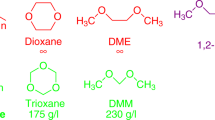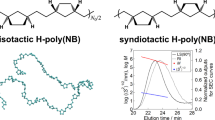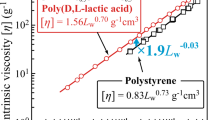Abstract
AN increase in the concentration of K2CO3 in Polyox WSR 205 causes a decrease in the drag reduction1; this has been successfully correlated with lowered values of the intrinsic viscosity1. Nonionic, water-soluble polypeptides can interact with sodium dodecyl sulphate (SDS) to form complexes2, and above a certain concentration the reduced viscosity of some of these polymers is increased. The immediate implication is that if such interactions also take place with polyethylene oxides of high molecular weight then changes in the observed drag reduction may occur.
This is a preview of subscription content, access via your institution
Access options
Subscribe to this journal
Receive 51 print issues and online access
$199.00 per year
only $3.90 per issue
Buy this article
- Purchase on Springer Link
- Instant access to full article PDF
Prices may be subject to local taxes which are calculated during checkout
Similar content being viewed by others
References
Little, R. C., Nature, 242, 79 (1973).
Murai, N., Makino, S., and Shintaro, S., J. Colloid Interface Sci., 41, 399 (1972).
Savins, J. G., in Viscous Drag Reduction (edit. by Wells, C. S.), 183 (Plenum Press, New York, 1969).
Savins, J. G., US Patent No. 3,361, 213 (1968).
Author information
Authors and Affiliations
Rights and permissions
About this article
Cite this article
PATTERSON, R., LITTLE, R. Interaction of sodium dodecyl sulphate and polyethylene oxide. Nature 253, 36–37 (1975). https://doi.org/10.1038/253036a0
Received:
Issue Date:
DOI: https://doi.org/10.1038/253036a0
This article is cited by
-
Turbulent-friction reduction in surfactant-polymer aqueous solutions
Journal of Engineering Physics (1988)
Comments
By submitting a comment you agree to abide by our Terms and Community Guidelines. If you find something abusive or that does not comply with our terms or guidelines please flag it as inappropriate.



